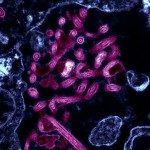Link to Pubmed [PMID] – 29150826
Ecohealth 2017 Dec;14(4):840-850
Zoonotic transmissions are a major global health risk, and human-animal contact is frequently raised as an important driver of transmission. A literature examining zooanthroponosis largely agrees that more human-animal contact leads to more risk. Yet the basis of this proposition, the term contact, has not been rigorously analyzed. To understand how contact is used to explain cross-species spillovers, we conducted a multi-disciplinary review of studies addressing human-nonhuman primate (NHP) engagements and pathogenic transmissions and employing the term contact. We find that although contact is frequently invoked, it is employed inconsistently and imprecisely across these studies, overlooking the range of pathogens and their transmission routes and directions. We also examine a related but more expansive approach focusing on human and NHP habitats and their spatial overlap, which can potentially facilitate pathogenic transmission. Contact and spatial overlap investigations cannot, however, explain the processes that bring together people, animals and pathogens. We therefore examine another approach that enhances our understanding of zoonotic spillovers: anthropological studies identifying such historical, social, environmental processes. Comparable to a One Health approach, our ongoing research in Cameroon draws contact, spatial overlap and anthropological-historical approaches into dialog to suggest where, when and how pathogenic transmissions between people and NHPs may occur. In conclusion, we call for zoonotic disease researchers to specify more precisely the human-animal contacts they investigate and to attend to how broader ecologies, societies and histories shape pathogen-human-animal interactions.


